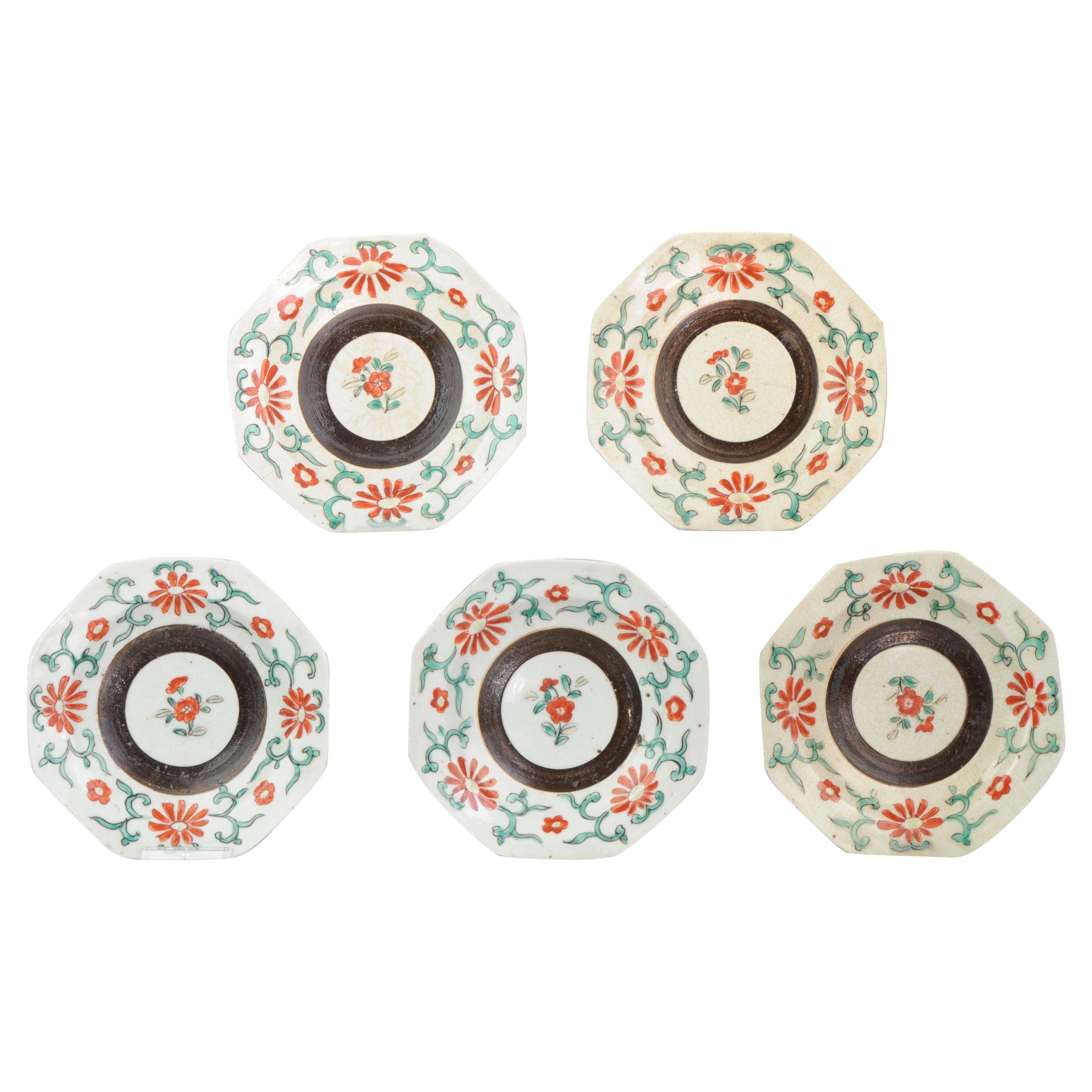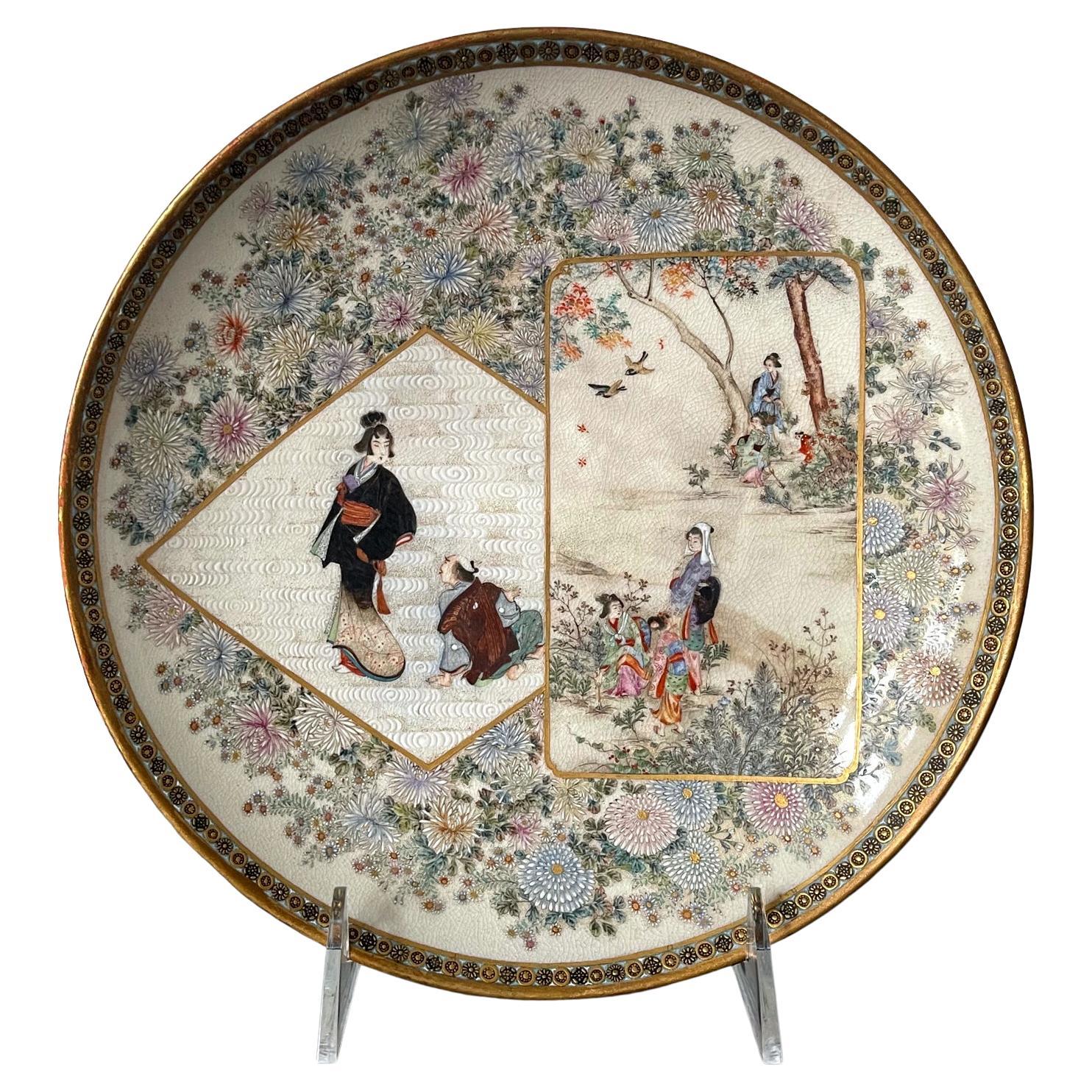Items Similar to Antique Japanese Ceramic Ko-Kutani Revival Footed Dish
Want more images or videos?
Request additional images or videos from the seller
1 of 19
Antique Japanese Ceramic Ko-Kutani Revival Footed Dish
About the Item
A Japanese glazed ceramic footed dish made in the Ko-Kutani type of Edo period but likely during Kutani revival in the 19th century Meiji Period. The dish with delicate foliaged rim is raised on a circular foot with cutout design. The piece is decorated with tri-color underglaze paint in yellow, green and purple. In the center, a songbird is depicted perched on the rocks, surrounded with leafed vines with well painted tendrils. The outer surrounding band is divided into eight parts and alternately decorated with green sayagata pattern (linked-swastika) and yellow lined-diamonds with cross in the center. The foot features a piratically interesting cutout leaf design. The underside of the dish is decorated with three scrolling floral motifs and marked with a green Fuku seal in the center within a circular indentation.
The origin of the Kutani ware can be traced to early Edo period (mid 17th century). The production thrived for a short period of time from 1655 to early 1700s before it disappeared. It was not until 19th century during Meiji period that Kutani ware was revived by specific kilns, and later transformed into the new more garish styles and widely exported to the west. This dish appears to be a Meiji revival piece to closely mimic the early Ko-Kutani piece for domestic collectors instead of export.
For a Ko-Kutani footed dish with a very similar design, see illustration 49-50 on page 51 of "Kutani Ware" by Sansaku Nakagawa (the page is shown in the last picture).
- Dimensions:Height: 2.2 in (5.59 cm)Diameter: 8.6 in (21.85 cm)
- Style:Japonisme (Of the Period)
- Materials and Techniques:Ceramic,Glazed
- Place of Origin:
- Period:
- Date of Manufacture:19th century
- Condition:Wear consistent with age and use. Three glaze drippings and overburn imperfection. General wear and even glaze crackles as expected.
- Seller Location:Atlanta, GA
- Reference Number:1stDibs: LU945029546002
About the Seller
5.0
Platinum Seller
These expertly vetted sellers are 1stDibs' most experienced sellers and are rated highest by our customers.
Established in 2006
1stDibs seller since 2010
479 sales on 1stDibs
Typical response time: <1 hour
- ShippingRetrieving quote...Ships From: Atlanta, GA
- Return PolicyA return for this item may be initiated within 2 days of delivery.
More From This SellerView All
- Japanese Yoshidaya Saiko Kutani Ceramic DishBy YoshidayaLocated in Atlanta, GAA Japanese Ao-Kutani stoneware dish with overglaze decoration in the shape of barbed quatrefoil shape from late Edo period, circa early mid-19th century. Around 1804, 100 years after Ko-Kutani (old-Kutani) ware disappeared abruptly after thriving from 1655-early 1700s, saiko-kutani (revived-kutani) was attempted by many kilns and several distinguished styles developed. Among them, Yoshidaya kiln attempted to revive the original style of Ko-Kutani known as Aote, which employed four dark colors: green, yellow, dark blue/black and aubergine to create bold and striking design. The Yoshidaya production was short-lived and lasted roughly from 1823-1831. This dish is likely dated from this period or shortly after. The overglaze design centered around a crouching tiger under a black bamboo grove in a deep green background, surrounded by luxuriant banana leaves in green and aubergine with black outlines. The base of a similar concentric barbed quatrefoil design is further decorated with black foliage outlines and marked with a square Fuku mark. For a Yoshidaya dish with identical shape but different landscape decoration, see lot 79 of sale 6547 Christie's London. Important Japanese and Chinese Art...Category
Antique 19th Century Japanese Japonisme Ceramics
MaterialsCeramic
- Japanese Satsuma Ceramic Dish with Fine Decoration by KinkozanBy KinkozanLocated in Atlanta, GAA satsuma ceramic dish made by Kinkozan studio circa 1980-1900s in the late Meiji Period. The dish with a thick robust wall is supported by a large ring base and features finely deta...Category
Antique Late 19th Century Japanese Meiji Ceramics
MaterialsCeramic
- Japanese Ceramic Bowl Makuzu Kozan Utusushi KenzanBy Makuzu KozanLocated in Atlanta, GAA rare ceramic bowl with over glaze painted decoration by Japanese imperial potter Makuzu Kozan ((1842–1916). Unlike the better known works Kozan made for the expositions in the west and export to the foreign market, this piece exemplifies his work for the domestic market and the tea ceremony. The bowl was made in the so called "Utusushi" Ogata Kenzan (1663-1743), an celebrated Edo painter and ceramicist. Utusushi is loosely translated as "in the spirit of". It is not at all a simple imitation of a master, but a Japanese concept of embracing the spiritual essence of a master while the creator is free to mix in his or her own unique artistic interpretation and flavor. The bowl was made to hold fruits during the tea ceremony. It has a very distinguished form with a circular lower body morphing into a square upper portion that further opening with flared rim. The surface has a grey glaze onto which Asagao flowers (Japanese morning glory) on the vines were painted in a free and poetic style. White was used for the petals, green for the leaves with touches of gold highlight. Asagao, the symbol of the summer was rendered in the spirit of Ogata Kenzan, and interestingly the shape of the blossom echoes the unique form the bowl. It was likely reserved for the tea ceremony during the summer months. Under the base, Kozan was signed in black on an white porcelain plaque inlay. For two similar examples of Kozan's work Utusushi Kenzan, see Page 168-169 of the book: Sekai ni Aisa Reta ya Kimono Miyagawa Kozan Makuzu...Category
Antique Early 1900s Japanese Japonisme Ceramics
MaterialsCeramic
- Japanese Oribe Square Dish by Kitaoji RosanjinBy Rosanjin KitaojiLocated in Atlanta, GAAn Oribe-Style rectangular dish with a slightly concaved slab body and up-turned irregular edges, made by Kitaoji Rosanjin (1883-1959) circa 1930-50s....Category
20th Century Japanese Modern Ceramics
MaterialsCeramic
- Japanese Oribe Glazed Stoneware Dish by Kitaoji RosanjinBy Rosanjin KitaojiLocated in Atlanta, GAAn oribe stoneware square dish with four notched corners and up-turned edges made by Kitaoji Rosanjin (1883-1959) circa 1950s. The Mingei style dish h...Category
20th Century Japanese Modern Ceramics
MaterialsCeramic
- A Massive Antique Japanese Arita Porcelain Plate by Kajiwara KilnLocated in Atlanta, GAOn offer is a truly impressive blue and white porcelain plate of Hizen ware, from Arita in Japan, circa mid to late-19th century. The plate was made by Kajiwara Kikujiro (菊次郎, the second Kiku son) and/or Kajiwara Kikusaburo (菊三郎, the third Kiku son who died in 1883) of the Kajiware Family Kiln of in Arita. It was decorated in a superb design with blue under-glaze, clearly out of a hand of a master. In a Classic Japanese composition that was popular in the Meiji Period, the plate displays a riot of auspicious elements, arranged still in a surprisingly harmonious manner. Anchoring the center of the design is an eagle perched on the branch of a blooming cherry tree, its talons clenching the bark and its wings about to open. The motion of the its immediate taking off is palpable. The trunk and the branches of the old cherry tree provide a spacial frame for the arrangement of large peonies with foliage, bundles of chrysanthemums, Chinese bell...Category
Antique 19th Century Japanese Japonisme Ceramics
MaterialsCeramic
You May Also Like
- # 5 Ko-Kutani Edo Period 17th Century Japanese Porcelain Dish AritaLocated in Amsterdam, Noord HollandA very nice set of polychrome dishes with green and red overglaze colors. Interesting brown circle in the centre. Early Edo period. Condition No real damages, just crackl...Category
Antique 18th Century Japanese Edo Ceramics
MaterialsPorcelain
- Edo Period Japanese Porcelain Plate Antique Ko-Kutani, Top QualityLocated in Amsterdam, Noord HollandA very nice Ko-Kutani plate, circa 1660-1680. See: Shibata collection Condition: Overall condition rim fritting and hairline. Size 205 x 132 mm ...Category
Antique 17th Century Chinese Edo Ceramics
MaterialsPorcelain
- Large Japanese Ko-Kutani Charger, Early 20th CenturyLocated in Melbourne, VictoriaA rare yellow ground Japanese ceramic charger 15.5 inches in diameter. Decorated on a yellow base with a bird, foliage and blossom in shades of yellow, blue, brown and green. S...Category
Early 20th Century Japanese Meiji Ceramics
MaterialsPorcelain
- Large Japanese Kutani Satsuma Bowl Hand-Painted Marked to Base, Circa 1940Located in Lincoln, LincolnshireThis is a high quality Earthenware Japanese Satsuma - Kutani large Bowl, beautifully hand decorated and dating to Circa 1940. This is a well potte...Category
Mid-20th Century Japanese Mid-Century Modern Decorative Bowls
MaterialsEarthenware
- Antique 19th Century Japanese Porcelain Yoshidaya Kutani Large Dish, JapanLocated in Amsterdam, Noord HollandSharing with you this lovely and unusal Kutani porcelain large dish. The dish is of circular form and has a scene of a wise man and his apprentice in a landscape scene. With beautiful colors and very nicely painted. Base marked with a Fuku mark...Category
Antique 19th Century Japanese Qing Ceramics
MaterialsPorcelain
- Octagonal Footed Chinoiserie Trinket Dish with Roosters & Floral Motif, SignedLocated in Oklahoma City, OKBeautiful chinoiserie footed vide poche or trinket dish. This piece would be fabulous for use as a trinket dish on a side table or nightstand. Its edges are octagonal and feature a s...Category
20th Century Chinese Chinoiserie Decorative Dishes and Vide-Poche
MaterialsCeramic, Paint
Recently Viewed
View AllMore Ways To Browse
Antique Foot
Ceramic Japan
Antique Brown Ceramics
Scroll Foot
Antique Furniture Foot Styles
Ceramics From Japan
Japanese Glazed Ceramic
Made In Japan Ceramics
Footed Ceramic
Japan Made Ceramic
Japanese Seal
Midcentury Japanese Ceramics
Asia Picture
Antique Dish Patterns
Cross Ceramic
Ceramic Scroll
Ceramic Japanese Style
Footed Dish





